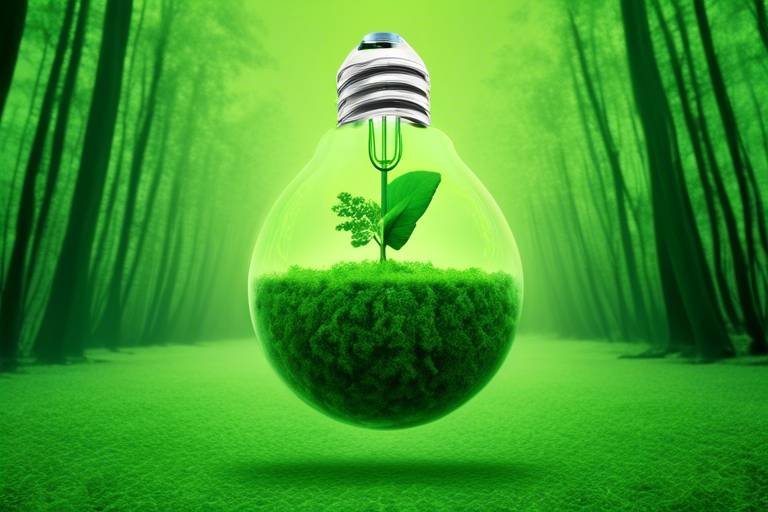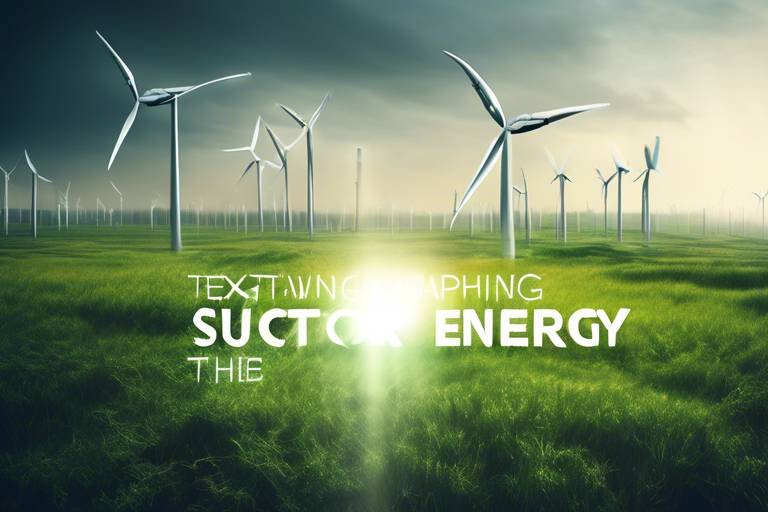Green Tech: Fighting Climate Change with Innovation
In today's world, the urgency to address climate change has never been more pressing. As we face the consequences of our past actions, it’s clear that innovation is key to paving the way toward a sustainable future. Enter green technology, a beacon of hope that harnesses the power of innovation to combat climate change. From renewable energy sources to energy-efficient practices, green tech is transforming how we live, work, and interact with our environment.
Imagine a world where our energy comes from the sun, the wind, and the water, instead of fossil fuels that choke our planet. This isn’t just a dream; it's becoming a reality through groundbreaking technologies that are reshaping our energy landscape. By investing in and adopting these technologies, we can significantly reduce carbon emissions, promote sustainability, and create a healthier planet for future generations.
As we delve into the various aspects of green tech, we'll explore how renewable energy sources like solar, wind, and hydroelectric power play a crucial role in this transformation. We'll also look at innovations in energy efficiency, sustainable transportation, and waste management technologies that are essential for reducing our carbon footprint.
With each innovation, we take a step closer to a world where sustainability is not just a buzzword but a way of life. The potential of green tech is immense, and as we continue to innovate, we can create solutions that not only fight climate change but also enhance our quality of life. So, buckle up as we embark on this exciting journey through the world of green technology!
Renewable energy sources such as solar, wind, and hydroelectric power play a crucial role in reducing carbon emissions and providing sustainable energy solutions for the future. These energy sources are abundant, clean, and sustainable, making them the backbone of a green energy revolution. For instance, solar panels can be installed on rooftops, allowing homeowners to generate their own electricity while reducing their reliance on fossil fuels.
Additionally, wind farms harness the power of the wind to produce electricity, and hydroelectric plants utilize flowing water to generate energy. These methods not only reduce greenhouse gas emissions but also create jobs and stimulate local economies. The shift towards renewable energy is not just beneficial for the environment; it’s a smart economic decision that can lead to long-term savings on energy costs.
Innovations in energy efficiency, including smart grids and energy-efficient appliances, are essential for reducing energy consumption and minimizing waste. By optimizing how we use energy, we can make significant strides in lowering our overall carbon footprint. Smart grid technology, for example, enhances electricity distribution, allowing for better energy management and integration of renewable sources.
Smart grid technology is a game-changer in the energy sector. It allows for real-time monitoring and management of energy consumption, ensuring that energy is used efficiently. This technology enhances the resilience of our energy infrastructure, making it less susceptible to outages and disruptions.
One of the most exciting aspects of smart grids is the implementation of demand response programs. These programs encourage consumers to reduce or shift their energy usage during peak periods, helping to balance supply and demand while lowering overall energy costs. Imagine being rewarded for using less energy during peak hours—this is the future of energy consumption!
Energy storage solutions, like batteries and pumped hydro, are also vital for storing excess energy generated from renewables. This ensures a stable energy supply even when production fluctuates. Think of it as a savings account for energy—when you produce more than you need, you can store it for a rainy day!
Energy-efficient buildings utilize advanced materials and technologies to minimize energy consumption, reduce greenhouse gas emissions, and enhance occupant comfort. These buildings are designed to maximize natural light, improve insulation, and utilize energy-efficient appliances, making them not only eco-friendly but also cost-effective in the long run.
Sustainable transportation solutions, including electric vehicles and public transit improvements, contribute significantly to reducing emissions from one of the largest sectors of greenhouse gas production. As cities grow, finding efficient ways to move people becomes increasingly important. Electric vehicles (EVs) are becoming increasingly popular as a cleaner alternative to traditional gasoline-powered vehicles, helping to decrease air pollution and reliance on fossil fuels.
Electric vehicles are revolutionizing the way we think about transportation. With zero tailpipe emissions, they offer a cleaner alternative that significantly reduces air pollution. Plus, as battery technology improves, EVs are becoming more affordable and accessible to the average consumer.
Innovations in public transit, such as electric buses and improved rail systems, promote sustainable urban mobility and reduce the carbon footprint of daily commutes. Imagine hopping onto an electric bus that not only gets you to your destination but does so without harming the planet. This is the future of public transportation, and it’s happening right now!
Advancements in waste management technologies, including recycling and composting, are essential for reducing landfill waste and promoting a circular economy. By rethinking how we manage waste, we can recover valuable resources and minimize our environmental impact.
Innovative recycling processes and materials recovery technologies help to divert waste from landfills and recover valuable resources. For example, advanced sorting technologies can separate materials more efficiently, ensuring that recyclables are processed correctly and reused.
Composting solutions provide an effective way to manage organic waste, transforming it into nutrient-rich soil while reducing methane emissions from landfills. By composting, we can close the loop on food waste and contribute to healthier soil and ecosystems.
1. What is green technology?
Green technology refers to the use of technology to create products and services that are environmentally friendly and sustainable. It includes renewable energy sources, energy-efficient practices, and waste management solutions.
2. How does renewable energy help combat climate change?
Renewable energy sources, such as solar and wind, produce little to no greenhouse gas emissions, making them essential for reducing our carbon footprint and mitigating climate change.
3. What are the benefits of energy-efficient buildings?
Energy-efficient buildings reduce energy consumption, lower utility bills, and minimize greenhouse gas emissions, all while providing a comfortable living or working environment.
4. How can I contribute to green technology initiatives?
You can contribute by adopting renewable energy sources, using energy-efficient appliances, supporting sustainable transportation options, and practicing recycling and composting in your daily life.

Renewable Energy Sources
When we think about the future of our planet, like solar, wind, and hydroelectric power emerge as the heroes of the story. Imagine a world where our energy needs are met without depleting the Earth’s resources or polluting the air we breathe. This isn’t just wishful thinking; it’s becoming a reality thanks to the advancements in green technology. These renewable sources play a crucial role in reducing carbon emissions and providing sustainable energy solutions for the future.
Let’s break it down a bit. Solar energy harnesses the power of the sun, turning sunlight into electricity through photovoltaic cells. With the sun shining down on us every day, it’s like having a giant power plant in the sky—free and abundant! Wind energy, on the other hand, captures the kinetic energy from the wind using turbines. Picture those massive wind farms dotting the landscape, spinning gracefully while generating clean energy. And then there's hydroelectric power, which uses flowing water to generate electricity. It’s like tapping into the natural flow of rivers, turning that movement into energy.
Here’s a quick comparison of these renewable energy sources:
| Energy Source | Key Benefits | Challenges |
|---|---|---|
| Solar Energy | Abundant, low maintenance, reduces electricity bills | Intermittent availability, requires space for panels |
| Wind Energy | Low operational costs, scalable, reduces reliance on fossil fuels | Dependent on wind conditions, can impact wildlife |
| Hydroelectric Power | Reliable, efficient, can provide flood control | Environmental impact on aquatic ecosystems, requires significant infrastructure |
By investing in these renewable energy technologies, we can create a more resilient energy system. Not only do they help in combating climate change, but they also foster energy independence. Imagine if every household could generate its own electricity from solar panels on their roofs! This shift not only reduces our reliance on fossil fuels but also empowers individuals and communities to take charge of their energy consumption.
Moreover, as technology advances, the cost of renewable energy continues to drop, making it more accessible to everyone. In fact, many regions are now seeing solar and wind energy as the cheapest forms of new electricity generation. This is a game-changer! The more we embrace these technologies, the closer we get to a sustainable future.
Ultimately, renewable energy sources are not just an alternative; they are the foundation of a sustainable energy future. As we transition away from fossil fuels, we must harness the potential of these green technologies to ensure a cleaner, healthier planet for generations to come. So, the next time you see a solar panel or a wind turbine, remember that it’s not just a piece of technology; it’s a step towards a brighter, greener future.

Energy Efficiency Innovations
In our quest to tackle climate change, have emerged as a beacon of hope, guiding us toward a more sustainable future. These innovations are not just about saving energy; they are about redefining how we consume it. Imagine a world where your home, office, and city operate seamlessly, using technology to optimize energy use while minimizing waste. This is the essence of energy efficiency, and it's becoming increasingly crucial as we face the consequences of our energy choices.
One of the most exciting advancements in this field is smart grid technology. Unlike traditional grids, which are often rigid and reactive, smart grids are dynamic and proactive. They utilize digital communication technology to monitor and manage electricity flows, allowing for real-time adjustments based on demand. This means that when you're cooking dinner or charging your electric vehicle, the grid can adapt, ensuring that energy is used efficiently and effectively. With smart grids, we can integrate renewable energy sources—like solar and wind—more reliably, reducing our dependence on fossil fuels and lowering carbon emissions.
Another innovative approach is the implementation of demand response programs. These programs encourage consumers to adjust their energy usage during peak demand times. For example, if everyone turns down their air conditioning during a hot summer afternoon, we can significantly reduce the strain on the grid. This not only helps in balancing supply and demand but also lowers overall energy costs for everyone involved. It’s a win-win situation that fosters a sense of community responsibility toward energy consumption.
But what happens when the sun sets or the wind dies down? This is where energy storage solutions come into play. Technologies such as advanced batteries and pumped hydro storage systems allow us to store excess energy generated during peak production times. Think of it like a savings account for energy: you deposit energy when it’s abundant and withdraw it when you need it. This ensures a stable energy supply, even when production fluctuates, and paves the way for a more resilient energy infrastructure.
Moreover, the push for energy efficiency extends to the very buildings we inhabit. Energy-efficient buildings are designed with advanced materials and technologies that minimize energy consumption while maximizing comfort. Imagine living in a home that maintains a comfortable temperature year-round without cranking up the thermostat. These buildings often incorporate features like high-performance insulation, energy-efficient windows, and smart home technology that allows homeowners to monitor and control their energy use effortlessly. By reducing greenhouse gas emissions, these innovations not only save money but also enhance the quality of life for occupants.
In conclusion, energy efficiency innovations are at the forefront of our fight against climate change. By embracing smart grids, demand response programs, energy storage solutions, and energy-efficient buildings, we can create a sustainable future that benefits both the planet and its inhabitants. The journey toward energy efficiency is not just a technical challenge; it is a fundamental shift in how we think about and interact with energy. As we move forward, it's essential to stay informed and engaged, paving the way for a greener tomorrow.
- What are energy efficiency innovations?
Energy efficiency innovations refer to new technologies and practices that reduce energy consumption while maintaining or improving performance and comfort. - How do smart grids work?
Smart grids use digital technology to monitor and manage electricity flows, allowing for real-time adjustments and integration of renewable energy sources. - What is a demand response program?
Demand response programs encourage consumers to reduce or shift their energy usage during peak periods to help balance supply and demand. - Why are energy storage solutions important?
Energy storage solutions allow us to store excess energy generated from renewables, ensuring a stable energy supply even when production fluctuates. - How can buildings be made more energy-efficient?
Buildings can be made more energy-efficient through the use of advanced materials, smart technology, and design practices that minimize energy consumption.

Smart Grid Technology
is revolutionizing the way we manage electricity distribution. Imagine a network that not only delivers power but also communicates in real-time, optimizing energy flow and enhancing reliability. This innovative approach combines traditional electricity systems with advanced digital technology, allowing for a more efficient and resilient energy infrastructure. By integrating renewable energy sources like solar and wind, smart grids enable a seamless transition to sustainable energy solutions, reducing our reliance on fossil fuels.
One of the most exciting aspects of smart grid technology is its ability to empower consumers. With smart meters, households can monitor their energy usage in real-time, leading to more informed decisions about consumption. This transparency encourages energy-saving behaviors and promotes a culture of sustainability. It's like having a personal energy coach right in your home, nudging you to turn off lights when you leave a room or to run appliances during off-peak hours.
Moreover, smart grids enhance the integration of renewable energy sources. As we know, renewable energy generation can be intermittent. However, smart grids can manage these fluctuations by balancing supply and demand effectively. For instance, when the sun is shining bright, solar panels generate excess energy. The smart grid can store this surplus in energy storage systems or redirect it to areas where demand is high. This flexibility is crucial for maintaining a stable energy supply, even when production levels vary.
Another key component of smart grid technology is demand response programs. These initiatives allow utility companies to incentivize consumers to reduce or shift their energy usage during peak periods. Think of it as a friendly reminder to turn down the thermostat or delay running the dishwasher until later in the evening. By participating in these programs, consumers not only lower their energy bills but also contribute to a more balanced energy grid, which can prevent blackouts and reduce the need for additional power plants.
To illustrate the impact of smart grid technology, consider the following table that outlines some of its benefits:
| Benefit | Description |
|---|---|
| Enhanced Reliability | Smart grids can quickly identify outages and reroute power, reducing downtime. |
| Increased Efficiency | Real-time data allows for better energy management and reduced waste. |
| Integration of Renewables | Facilitates the use of solar, wind, and other renewable sources in the energy mix. |
| Consumer Empowerment | Smart meters provide insights into energy usage, encouraging conservation. |
In conclusion, smart grid technology is not just a buzzword; it's a transformative approach that enhances our energy systems. By fostering a more interactive and efficient energy network, we can significantly reduce our carbon footprint and move towards a sustainable future. As we continue to innovate in this space, the potential for smart grids to reshape our energy landscape is truly exciting.
- What is a smart grid? A smart grid is an electricity supply network that uses digital technology to monitor and manage the transport of electricity from all generation sources to meet the varying electricity demands of end users.
- How does smart grid technology benefit consumers? It provides real-time data on energy usage, encourages energy-saving behaviors, and offers incentives for reducing usage during peak times.
- Can smart grids integrate renewable energy sources? Yes, smart grids are designed to facilitate the integration of renewable energy sources, helping to manage fluctuations in supply and demand.
- What are demand response programs? These programs encourage consumers to adjust their energy usage during peak times, often through incentives, to help balance the grid and reduce the risk of outages.

Demand Response Programs
Demand response programs are like a symphony conductor, orchestrating the flow of energy usage to create harmony between supply and demand. Imagine a bustling city during rush hour, where everyone is trying to get to their destination at the same time. It’s chaotic, right? Now, picture a scenario where some commuters decide to travel a little earlier or later, easing the congestion. This is essentially what demand response programs aim to achieve in the energy sector. They incentivize consumers to shift or reduce their electricity consumption during peak periods, which not only helps in balancing the grid but also lowers overall energy costs.
These programs operate on the principle of flexibility. When energy demand spikes—think of those hot summer days when everyone cranks up their air conditioning—demand response programs kick in. They encourage households and businesses to reduce their energy use during these peak times. This can be done through various means, such as adjusting thermostats, turning off non-essential lights, or delaying the use of certain appliances. In return, participants often receive financial incentives, making it a win-win situation.
To give you a clearer picture, let’s break down how these programs typically work:
| Step | Description |
|---|---|
| 1 | Notification: Consumers are alerted when peak demand is expected. |
| 2 | Action: Participants reduce or shift their energy usage accordingly. |
| 3 | Incentive: Consumers receive compensation for their participation. |
Moreover, these programs are not just beneficial for the consumers; they also contribute significantly to the stability of the energy grid. By managing demand effectively, utilities can avoid the need to activate expensive and less environmentally-friendly peaker plants, which are often used during high demand periods. This leads to lower emissions and a more sustainable energy ecosystem.
In essence, demand response programs are a crucial component of modern energy management. They represent a shift towards a more interactive and responsive energy system, where consumers play an active role in the energy landscape. As we move towards a more sustainable future, these programs will undoubtedly become more prevalent, empowering individuals and businesses to contribute to a greener planet.
- What is a demand response program?
A demand response program is an initiative that encourages consumers to reduce or shift their electricity usage during peak demand times in exchange for financial incentives. - How can I participate in a demand response program?
Participation typically involves signing up with your utility provider, who will provide you with guidelines on how to reduce your energy usage during peak times. - Are there any costs associated with demand response programs?
Generally, there are no costs to participate; in fact, you can earn money or credits on your utility bill by reducing your energy consumption. - Will participating in these programs affect my comfort?
Not necessarily! Many programs are designed to allow you to maintain comfort while still reducing energy usage, such as adjusting thermostats slightly during peak times.

Energy Storage Solutions
Energy storage solutions are the unsung heroes of the renewable energy revolution. Imagine a world where the sun shines bright during the day, and the wind howls at night, but we can’t harness that energy when we need it most. This is where energy storage comes into play, acting like a sponge that soaks up excess energy and releases it when demand peaks. The most common forms of energy storage include batteries, pumped hydro, and flywheels, each with its own unique advantages and applications.
One of the most popular energy storage technologies is batteries. Lithium-ion batteries, for instance, are widely used in electric vehicles and residential solar energy systems. They store energy generated during peak sunlight hours and release it when the sun sets. This not only helps in maintaining a consistent energy supply but also reduces reliance on fossil fuels. The rapid advancements in battery technology are making them more efficient, affordable, and environmentally friendly. However, it's essential to consider the lifecycle of these batteries, including their production and disposal, to ensure they contribute positively to sustainability.
Pumped hydro storage is another fascinating technology. It works by using excess energy to pump water uphill to a reservoir. When energy is needed, the water is released back down, turning turbines to generate electricity. This method has been around for decades and is one of the most effective large-scale energy storage solutions available. It’s like having a giant water battery that can store energy for days or even weeks, depending on the reservoir's capacity.
Additionally, flywheels provide a different approach to energy storage. They store energy in the form of kinetic energy by spinning a rotor at high speeds. When energy is needed, the rotational energy is converted back into electricity. Flywheels are known for their rapid response times and high cycle life, making them ideal for stabilizing grid fluctuations and supporting renewable energy integration.
Ultimately, the choice of energy storage solution depends on various factors, including the scale of energy needs, geographical location, and specific application requirements. As we continue to innovate and improve these technologies, we move closer to a future where renewable energy can be harnessed efficiently and stored for use whenever it's needed. The growing demand for energy storage solutions is not just a trend; it’s a crucial step towards achieving a sustainable energy future.
- What are the main types of energy storage solutions? The main types include batteries, pumped hydro storage, and flywheels.
- How do batteries work in energy storage? Batteries store energy chemically and release it as electricity when needed.
- What are the environmental impacts of energy storage technologies? While they help reduce fossil fuel reliance, it's important to consider the lifecycle impacts of materials used in their production and disposal.
- Are energy storage solutions cost-effective? Yes, with ongoing advancements and economies of scale, energy storage is becoming increasingly affordable.

Energy-Efficient Buildings
In today’s world, the concept of has taken center stage in the fight against climate change. These structures are designed not just to provide shelter but to do so in a way that significantly minimizes energy consumption and reduces greenhouse gas emissions. Imagine living in a home that not only keeps you comfortable but also actively contributes to a healthier planet. Sounds appealing, right? Well, that’s the magic of energy-efficient buildings!
One of the key features of these buildings is their use of advanced materials and technologies. For instance, high-performance insulation helps to keep the heat in during winter and the cool air in during summer. This means that less energy is needed for heating and cooling, which translates to lower utility bills. Moreover, energy-efficient windows, often double or triple-glazed, prevent heat loss and reduce the need for artificial lighting during the day.
But it doesn't stop there! The integration of renewable energy sources is another hallmark of energy-efficient buildings. Many of these structures are equipped with solar panels that harness the sun's energy, generating electricity that can be used on-site. This not only reduces reliance on fossil fuels but can also lead to energy independence for homeowners. Picture a future where your home is not just a place to live but a mini power plant!
Furthermore, energy-efficient buildings often feature smart technology that optimizes energy use. Smart thermostats, for example, can learn your habits and adjust heating and cooling accordingly, ensuring that energy is used only when needed. This technology not only enhances comfort but also contributes to substantial energy savings over time. In fact, studies have shown that buildings equipped with smart technology can reduce energy consumption by up to 30%!
To illustrate the impact of energy-efficient buildings, consider the following table that compares energy consumption in traditional buildings versus energy-efficient ones:
| Building Type | Annual Energy Consumption (kWh/m²) | Estimated Carbon Emissions (kg CO2/m²) |
|---|---|---|
| Traditional Building | 200 | 50 |
| Energy-Efficient Building | 100 | 25 |
This table clearly shows that energy-efficient buildings consume significantly less energy and produce fewer carbon emissions, making them a vital part of the sustainability puzzle. Not only do they help in reducing the overall carbon footprint, but they also enhance occupant comfort and health, creating a win-win situation for everyone involved.
In conclusion, the shift towards energy-efficient buildings is not just a trend; it’s a necessity in our quest for a sustainable future. By embracing innovative designs and technologies, we can create living spaces that are not only functional but also environmentally friendly. So, whether you’re planning to build a new home or renovate an existing one, consider energy efficiency as a top priority. It’s an investment that pays off in more ways than one!
- What are energy-efficient buildings? Energy-efficient buildings are designed to use less energy for heating, cooling, and lighting, thereby reducing their environmental impact.
- How do energy-efficient buildings save money? By using less energy, these buildings lead to lower utility bills and can often qualify for tax incentives or rebates.
- Can I retrofit my existing home to be more energy-efficient? Absolutely! Many upgrades, such as improved insulation, energy-efficient windows, and smart technology, can be implemented in existing structures.

Sustainable Transportation
Sustainable transportation is no longer just a buzzword; it’s a necessity for our planet’s future. As we grapple with the harsh realities of climate change, the way we move from point A to point B must evolve. Traditional vehicles, powered by fossil fuels, are major culprits in greenhouse gas emissions, contributing significantly to air pollution and climate change. But fear not! The rise of sustainable transportation options is here to save the day, and it’s more exciting than ever!
Imagine a world where the air is cleaner, cities are quieter, and transportation is efficient and eco-friendly. This isn’t a far-off dream; it’s happening right now! Electric vehicles (EVs) are at the forefront of this revolution, offering a cleaner alternative to their gasoline-powered counterparts. With advancements in battery technology, EVs are becoming more affordable and have a longer range than ever before. The shift to electric not only reduces air pollution but also decreases our reliance on fossil fuels, making it a win-win for both consumers and the environment.
But it doesn’t stop with electric vehicles. Sustainable transportation encompasses a broader range of solutions that include public transit innovations. Cities around the globe are investing in electric buses, which are not only quieter but also produce zero tailpipe emissions. These buses are becoming a staple in urban areas, making public transit more appealing and accessible. Additionally, improvements in rail systems, such as high-speed trains and light rail, are helping to reduce the carbon footprint of daily commutes. When public transit is efficient and reliable, people are more likely to leave their cars at home, which is a significant step toward reducing overall emissions.
Moreover, sustainable transportation isn’t limited to just vehicles. It also involves creating infrastructure that supports walking and cycling. Cities are reimagining their layouts to include bike lanes, pedestrian pathways, and green spaces, encouraging residents to opt for healthier, more sustainable modes of transport. This not only reduces emissions but also promotes a healthier lifestyle, as people engage more in physical activity.
In addition to these innovations, the concept of shared mobility is gaining traction. Services like car-sharing and ride-hailing apps are transforming the way we think about transportation. By reducing the number of vehicles on the road, shared mobility solutions can significantly decrease congestion and emissions. Imagine a city where you can summon a ride at the touch of a button, reducing the need for personal car ownership and the associated environmental impact.
To sum it up, sustainable transportation is a multifaceted approach that combines electric vehicles, improved public transit, infrastructure for walking and cycling, and shared mobility solutions. Each of these elements plays a crucial role in creating a cleaner, more efficient transportation system. As we embrace these innovations, we are not only making strides toward a sustainable future but also enhancing our quality of life. So, let’s buckle up and get ready to drive into a greener tomorrow!
- What are electric vehicles? Electric vehicles (EVs) are cars that are powered by electricity instead of gasoline, making them a cleaner alternative for the environment.
- How do public transit innovations contribute to sustainability? Innovations in public transit, like electric buses and improved rail systems, help reduce the number of personal vehicles on the road, leading to lower emissions.
- What is shared mobility? Shared mobility refers to transportation services that allow multiple users to share rides or vehicles, reducing the overall number of cars needed and decreasing traffic congestion.
- Why is infrastructure important for sustainable transportation? Infrastructure such as bike lanes and pedestrian pathways encourages walking and cycling, which are eco-friendly alternatives to driving.

Electric Vehicles
Electric vehicles (EVs) are not just a trend; they are a revolution in the way we think about transportation and energy consumption. Imagine driving a car that produces zero emissions while contributing to a cleaner, more sustainable planet. With advancements in battery technology and charging infrastructure, EVs are becoming a viable option for more people every day. They offer a cleaner alternative to traditional gasoline-powered vehicles, which are notorious for their contribution to air pollution and greenhouse gas emissions. The shift towards electric vehicles is crucial, and it's happening faster than you might think!
One of the most exciting aspects of EVs is their environmental impact. According to recent studies, switching to electric vehicles can significantly reduce your carbon footprint. For instance, an average gasoline car emits about 4.6 metric tons of carbon dioxide per year, while an electric vehicle can cut that down to nearly zero when powered by renewable energy sources. This transition is not just beneficial for the planet; it also offers economic advantages for consumers. Electric vehicles typically have lower operating costs due to fewer moving parts, reduced maintenance needs, and the lower cost of electricity compared to gasoline.
Moreover, the infrastructure for electric vehicles is rapidly expanding. Charging stations are popping up in urban areas, along highways, and even in residential neighborhoods. The convenience of being able to charge your car at home overnight or during errands is a game-changer. Some EVs even offer fast-charging options that can provide a significant charge in as little as 30 minutes!
But what about the range anxiety that many potential EV owners worry about? It's true that early models had limited ranges, but modern electric vehicles are equipped with advanced battery technology that allows for longer distances without needing a charge. Many new EVs can travel over 300 miles on a single charge, making them practical for long-distance travel. Plus, with the growing network of charging stations, finding a place to recharge is becoming easier and more accessible.
In summary, electric vehicles are paving the way for a more sustainable future. They not only help reduce our reliance on fossil fuels but also promote a cleaner environment. As the technology continues to improve and the infrastructure expands, we can expect to see even more people making the switch to electric. So, are you ready to join the EV revolution?
- What are the benefits of electric vehicles?
Electric vehicles offer numerous benefits, including lower emissions, reduced fuel costs, and less maintenance compared to traditional vehicles. - How long does it take to charge an electric vehicle?
Charging times can vary based on the charging station and vehicle, but many can be charged in under an hour using fast chargers. - What is the range of electric vehicles?
Modern electric vehicles can typically travel between 200 to 400 miles on a single charge, depending on the model and driving conditions. - Are there incentives for buying electric vehicles?
Many governments offer tax credits, rebates, and other incentives to encourage the purchase of electric vehicles.

Public Transit Innovations
When it comes to tackling climate change, are emerging as a game changer. Imagine a world where hopping on a bus or train is as routine as breathing, yet it contributes significantly to lowering our carbon footprint. With the rise of electric buses, high-speed rail systems, and integrated transit apps, public transportation is becoming not just a necessity but a beacon of sustainability.
One of the most exciting developments in this arena is the introduction of electric buses. These vehicles are revolutionizing the way we think about public transport. Unlike their diesel counterparts, electric buses produce zero tailpipe emissions, which means cleaner air for everyone. Cities like Los Angeles and London have already begun to replace their aging fleets with electric models, and the results are promising. Not only do these buses reduce greenhouse gas emissions, but they also provide a smoother, quieter ride for passengers.
But it doesn't stop there. High-speed rail systems are also making waves in the public transit sector. These trains, which can travel at speeds exceeding 200 miles per hour, connect cities more efficiently than ever before. For instance, the Shinkansen in Japan has become a model for the world, showcasing how rail can be both fast and environmentally friendly. By providing an alternative to air travel, high-speed trains can significantly cut down on emissions associated with flying.
Moreover, the integration of smart technology into public transit systems is enhancing the overall user experience. Imagine an app that not only tells you when the next bus is arriving but also allows you to pay for your fare, check real-time updates, and even plan your route based on the least crowded options. This level of convenience encourages more people to opt for public transportation over personal vehicles, which is a win-win for both commuters and the environment.
As cities continue to innovate, we can expect to see more initiatives that promote sustainable urban mobility. These might include dedicated bus lanes, bike-sharing programs, and pedestrian-friendly infrastructure. By prioritizing public transit, urban planners are not just making life easier for commuters; they’re also paving the way for a greener future.
In conclusion, public transit innovations are not merely trends; they represent a fundamental shift in how we approach transportation. By embracing electric vehicles, high-speed rail, and smart technology, we can create a more sustainable and efficient public transit system that benefits everyone. So, the next time you consider your commute, think about the impact of your choices—because every ride counts in the fight against climate change.
- What are the benefits of electric buses? Electric buses reduce air pollution, provide a quieter ride, and lower operational costs in the long run.
- How do high-speed trains help the environment? By offering a faster alternative to air travel, high-speed trains can significantly reduce greenhouse gas emissions associated with flying.
- What role does technology play in public transit? Technology enhances user experience through real-time updates, fare payments, and route planning, making public transit more appealing.
- Are there any incentives for using public transit? Many cities offer discounts or subsidies for public transit users, making it a more economical choice compared to driving.

Waste Management Technologies
In today's world, where environmental concerns are at the forefront of global discussions, have emerged as a pivotal factor in promoting sustainability. With the increasing volume of waste generated by urban populations, it has become essential to adopt innovative methods that not only reduce landfill waste but also recover valuable resources. The shift towards a circular economy—where waste is minimized and materials are reused—is being driven by advancements in both recycling and composting technologies.
One of the most significant developments in waste management is the evolution of recycling technologies. Modern recycling processes have become more efficient, enabling us to separate and recover materials from waste streams with greater precision. For instance, advanced sorting technologies, such as optical sorting systems and robotic arms, can identify different materials and sort them accordingly. This not only increases the rate of recycling but also ensures that less waste ends up in landfills. According to recent studies, these technologies can improve recycling rates by up to 30%.
In addition to recycling, composting solutions have gained traction as an effective method for managing organic waste. Composting transforms food scraps and yard waste into nutrient-rich soil, which can then be used to enrich gardens and agricultural lands. This process not only diverts waste from landfills—where it would otherwise produce harmful methane emissions—but also contributes to soil health and reduces the need for chemical fertilizers. With the rise of home composting systems and community composting initiatives, individuals and local governments are playing a crucial role in this sustainable practice.
To further illustrate the impact of these technologies, consider the following table that highlights the benefits of recycling and composting:
| Technology | Benefits |
|---|---|
| Recycling |
|
| Composting |
|
As we look towards the future, the integration of these waste management technologies will be vital in mitigating the environmental impact of waste. By embracing innovation and promoting sustainable practices, we can significantly reduce our carbon footprint and transition towards a more sustainable society. The collaboration between governments, businesses, and individuals is essential to drive these changes and ensure that waste is managed effectively.
1. What are waste management technologies?
Waste management technologies refer to the methods and systems used to handle, treat, and dispose of waste in an environmentally friendly manner. This includes recycling, composting, and advanced sorting technologies.
2. How does recycling help the environment?
Recycling helps the environment by reducing the amount of waste sent to landfills, conserving natural resources, decreasing energy consumption, and lowering greenhouse gas emissions.
3. What is composting, and why is it important?
Composting is the process of breaking down organic waste into nutrient-rich soil. It is important because it diverts waste from landfills, reduces methane emissions, and enhances soil health.
4. How can I participate in waste management efforts?
You can participate in waste management efforts by recycling, composting at home, supporting local waste management initiatives, and spreading awareness about sustainable practices in your community.

Recycling Innovations
In the ever-evolving landscape of sustainability, stand out as a beacon of hope. As we grapple with the consequences of waste accumulation, these advancements promise not only to mitigate environmental impact but also to transform how we perceive and manage resources. Imagine a world where discarded materials are not seen as trash but as valuable assets waiting to be repurposed. This shift in mindset is crucial, and it's being driven by groundbreaking technologies and processes that redefine recycling.
One of the most exciting developments in this field is the use of advanced sorting technologies. These innovations utilize artificial intelligence and machine learning to improve the efficiency of sorting recyclables. Traditional recycling facilities often struggle with contamination—when non-recyclable items are mixed with recyclables, it complicates the recycling process. However, with AI-powered systems, facilities can now accurately identify and separate materials, ensuring that more items are processed correctly. This not only increases the recycling rate but also reduces the amount of waste sent to landfills.
Furthermore, the introduction of chemical recycling is revolutionizing how we handle plastics. Unlike mechanical recycling, which can degrade the quality of materials, chemical recycling breaks down plastics into their original monomers, allowing them to be reused in new products without loss of quality. This process is particularly important for complex plastics that are difficult to recycle through conventional means. By embracing chemical recycling, we can significantly reduce the environmental burden of plastic waste.
Another noteworthy advancement is the development of biodegradable materials that can replace traditional plastics. These materials are designed to break down more easily in the environment, reducing the long-term impact of waste. Companies are increasingly investing in research to create alternatives that maintain the functionality of conventional plastics while being more environmentally friendly. Imagine a world where the packaging of your favorite snacks decomposes naturally, leaving no trace behind!
To truly grasp the impact of these innovations, let’s take a look at some statistics:
| Innovation | Impact on Recycling Rates | Environmental Benefit |
|---|---|---|
| AI Sorting Technology | Increases recycling rates by up to 30% | Reduces landfill waste and contamination |
| Chemical Recycling | Can recycle up to 90% of plastics | Reduces reliance on virgin materials |
| Biodegradable Materials | Potential to replace 50% of single-use plastics | Less pollution and lower carbon footprint |
These innovations are not just theoretical; they are already being implemented in various parts of the world. Cities are adopting smart recycling bins equipped with sensors that notify waste management services when they are full, optimizing collection routes and reducing emissions from garbage trucks. Additionally, community programs are being established to educate the public about proper recycling practices, ensuring that everyone plays a part in this crucial effort.
As we look to the future, the potential for recycling innovations seems boundless. By embracing these technologies and fostering a culture of sustainability, we can pave the way for a cleaner, greener planet. The challenge lies not just in developing these solutions but in integrating them into our everyday lives. So, the next time you toss something in the recycling bin, remember: you’re not just disposing of waste; you’re participating in a global movement towards a more sustainable future.
- What is chemical recycling? Chemical recycling is a process that breaks down plastics into their original monomers, allowing them to be reused without loss of quality.
- How does AI improve recycling? AI improves recycling by accurately sorting materials, reducing contamination, and increasing overall recycling rates.
- What are biodegradable materials? Biodegradable materials are designed to break down more easily in the environment, reducing long-term waste impact.
- Can recycling technologies really make a difference? Yes, these technologies can significantly increase recycling rates and reduce environmental pollution.

Composting Solutions
Composting solutions are revolutionizing the way we manage organic waste, transforming it from a potential environmental hazard into a valuable resource. Imagine a world where food scraps and yard waste don’t just end up in landfills, producing harmful methane gas, but instead are turned into nutrient-rich soil that can nourish gardens and landscapes. Composting is like nature’s recycling process, breaking down organic materials through the natural action of microorganisms, worms, and other decomposers.
One of the most significant benefits of composting is its ability to reduce landfill waste. In fact, food waste constitutes a substantial portion of what we throw away—about 30-40% of the food supply in the U.S. alone ends up in landfills. By composting, we can divert this waste and significantly lower our carbon footprint. Not only does composting help the environment, but it also enriches the soil, enhances plant growth, and reduces the need for chemical fertilizers.
There are various composting methods available, each suitable for different needs and settings. Here are some popular composting solutions:
- Backyard Composting: This is the most common method, where individuals create compost piles or bins in their backyards. It’s ideal for those with space and the desire to engage in the process.
- Vermicomposting: Utilizing worms to break down organic material, this method is perfect for small spaces, such as apartments. Worms can consume a variety of food scraps, turning them into high-quality compost.
- Municipal Composting Programs: Many cities have established composting programs where residents can drop off their organic waste for large-scale composting. This is a fantastic way to ensure that waste is managed sustainably.
Implementing composting solutions can be straightforward. Start by setting up a compost bin in your backyard or even indoors if space allows. The key ingredients for successful composting include:
| Green Materials | Brown Materials |
|---|---|
| Fruit and vegetable scraps | Dried leaves |
| Coffee grounds | Cardboard |
| Grass clippings | Pine needles |
| Eggshells | Shredded paper |
By balancing these materials, you create a thriving environment for microorganisms to break down the waste. The result? Rich, dark compost that can be used to enhance your garden, improve soil health, and support plant growth. Plus, composting can save you money on fertilizers and help you grow your own food, making it a win-win for your wallet and the planet.
In conclusion, adopting composting solutions is a simple yet effective way to contribute to sustainability efforts. It’s not just about reducing waste; it’s about embracing a cycle of life that benefits the environment, our gardens, and ultimately, our health. So why not start composting today? Your garden (and the Earth) will thank you!
- What can I compost? Most organic materials, including fruit and vegetable scraps, coffee grounds, eggshells, and yard waste, can be composted. Avoid meat, dairy, and oily foods, as they can attract pests.
- How long does it take to compost? Composting can take anywhere from a few weeks to several months, depending on the materials used and the composting method.
- Can I compost in an apartment? Yes! Vermicomposting is an excellent solution for apartment dwellers, as it requires minimal space and can be done indoors.
- Is composting expensive? No, composting can be done at little to no cost. You can create your own compost bin using materials you already have at home.
Frequently Asked Questions
- What are renewable energy sources?
Renewable energy sources are natural resources that are replenished faster than they are consumed. Examples include solar, wind, and hydroelectric power. These sources help reduce carbon emissions and provide sustainable energy solutions for a cleaner future.
- How does smart grid technology work?
Smart grid technology enhances the electricity distribution system by using digital communication tools to monitor and manage the transport of electricity from all generation sources to meet the varying electricity demands of end-users. It allows for better energy management and integration of renewable sources.
- What are demand response programs?
Demand response programs are initiatives that encourage consumers to reduce or shift their energy usage during peak periods. This helps balance supply and demand, ultimately lowering energy costs and enhancing the efficiency of the energy grid.
- Why are energy storage solutions important?
Energy storage solutions, like batteries and pumped hydro, are crucial for storing excess energy generated from renewable sources. They ensure a stable energy supply even when production fluctuates, making renewable energy more reliable.
- What makes a building energy-efficient?
Energy-efficient buildings utilize advanced materials and technologies to minimize energy consumption. They often feature better insulation, energy-efficient appliances, and smart technologies that enhance occupant comfort while reducing greenhouse gas emissions.
- How do electric vehicles contribute to sustainability?
Electric vehicles (EVs) are cleaner alternatives to traditional gasoline-powered vehicles. They help decrease air pollution and reduce reliance on fossil fuels, making transportation more sustainable and environmentally friendly.
- What innovations are being made in public transit?
Innovations in public transit include the introduction of electric buses and improved rail systems. These advancements promote sustainable urban mobility and significantly reduce the carbon footprint associated with daily commutes.
- What are some advancements in waste management technologies?
Advancements in waste management technologies include innovative recycling processes and composting solutions. These help divert waste from landfills, recover valuable resources, and manage organic waste effectively, contributing to a circular economy.
- How does composting benefit the environment?
Composting transforms organic waste into nutrient-rich soil, which can be used in gardening and agriculture. It also reduces methane emissions from landfills, making it an effective solution for managing organic waste sustainably.



















